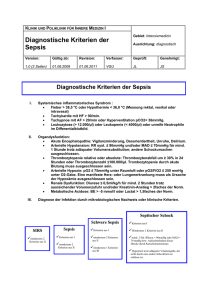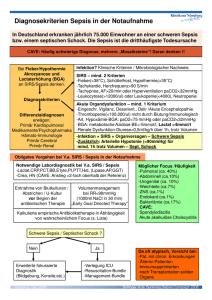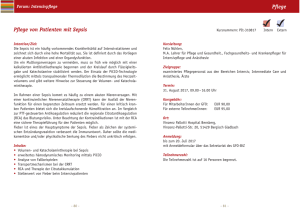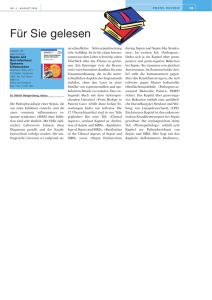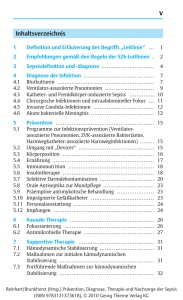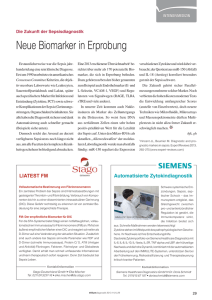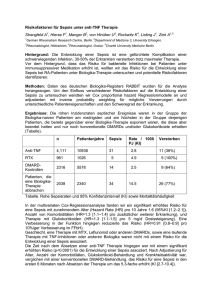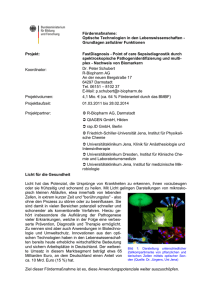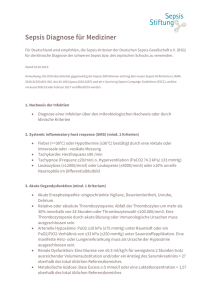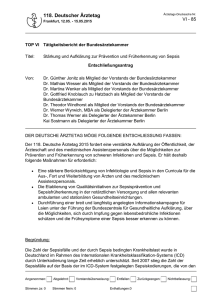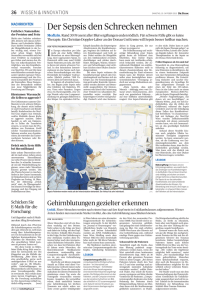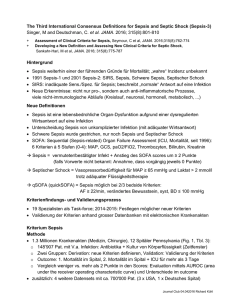Clinical Medicine: Inflammation during Shock and Sepsis
Werbung
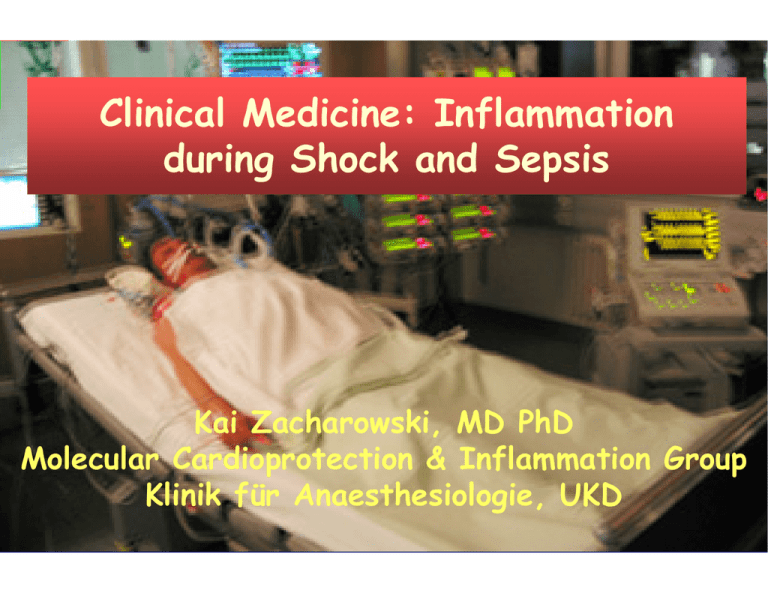
Clinical Medicine: Inflammation during Shock and Sepsis Kai Zacharowski, MD PhD Molecular Cardioprotection & Inflammation Group Klinik für Anaesthesiologie, UKD SepNet www.sepsis-gesellschaft.de Das Expertenwissen … Sepsis … ist über viele Fachdisziplinen hinweg verstreut; eine feste Zuordnung zu einer medizi. Fachdisziplin fehlt… Die ausgeprägte Interdisziplinarität hat negative Auswirkungen auf die Lehre and den Universitäten, denn keine einzelne Fachdisziplin fühlt sich … verantwortlich … Ausbildung von Ärzten und Studenten … sowie Fort- und Weiterbildung … SepNet 2005 www.sepsis-gesellschaft.de In Deutschland - Blutvergiftung dritthäufigste Todesursache… - 162 Tote/Tag - Inzidenz: 154.000 www.kompetenznetz-sepsis.de Infektion/ Trauma SIRS Sepsis Eine klinische Reaktion auf einen nichtspezifischen Insult, die 2 oder mehr der folgenden Symptome aufweist Temp. Herzfreq. Atemfreq. Leukozyten > > > > Bone et al. Chest 1992 Schwere Sepsis SIRS mit angenommener oder nachgewiesener Infektion 38°C or < 36°C 90/min 20/min 12.000 or < 4000/mm3 or > 10 % unreife Neutrophile SIRS = Systemic Inflammatory Response Syndrom Infektion/ Trauma SIRS Sepsis Schwere Sepsis Sepsis mit ≥ 1 Organversagen Renal Respiratorisch Hepatisch Hämatologisch ZNS Kardiovaskulär (refraktäre Hypotension) Schock Bone et al. Chest 1992 Wheeler & Bernard. N Engl J Med 1999 28-Tage Sterblichkeit SIRS: 10 % Sepsis: 20 % Schwere Sepsis: 20 – 40 % Septischer Schock: 40 – 80 % USA: Haupttodesursache anaesth./chir. ICUs ~ 200.000 Tote/Jahr (~ akuter MI) ~ 17 Milliarden $/Jahr Brun-Buisson C. ICM 2000; Friedman et al. CCM 1998 Krankheitsfälle pro 100.000 Einwohner/Jahr Aids Darm krebs Brustkrebs Sepsis 17 80 112 300 Sepsis: Eine wachsende Herausforderung für das Gesundheitswesen Zukunft Heute >1,5 Millionen Fälle schwerer Sepsis* ~ Sepsisfälle auf der Intensivstation 1995 *OECD = Organization for Economic Cooperation and Development Linde-Zwirble et al. CCM 1999; aus: Opal und Cohen, CCM 1999. Steigende Zahl älterer Mitbürger Lebenserhaltende Technologien Invasive Techniken und Verfahren Ambulant erworbene Infektionen Nosokomiale Infektionen Antibiotika-Resistenz Das neue Verständnis der Sepsis-Pathophysiologie Sepsis Gerinnung Endothelschädigung Fibrinolyse Organversagen Tod Inflammation normal Hyperinflammation Immunparalyse Immunstatus Gesunde Person mit Meningokokkeninfektion Älterer Herr mit Divertikulose ☺ Patient mit Diabetes, Niereninsuff. und Pneumonie 1 2 3 4 days 5 6 7 8 ´Current Concepts´ 1.1.kausale kausaleantimikrobielle antimikrobielle//operativ-interventionelle operativ-interventionelleHerdsanierung Herdsanierung a 2. 2.ARDS-Beatmung ARDS-Beatmung(12 (12vs vs66ml/kg ml/kgBW): BW):Sterblichkeit Sterblichkeit↓↓39.8 39.8vs vs31.0 31.0(p=0.007) (p=0.007)a 3. 3.EGDT EGDT((early earlygoal goaldirected directedtherapy therapy):):frühzeitige frühzeitige++aggressive aggressiveOptimierung Optimierungder der b kardiozirkulator. kardiozirkulator.Funktion; Funktion;28-Tage 28-TageLetalität Letalität↓↓46.5 46.5vs vs30.5 30.5(p<0.009) (p<0.009)b 4. 4.Normalisierung NormalisierungBlutzuckers Blutzuckers(80-110 (80-110vs vs-215 -215mg/dl): mg/dl):Sterblichkeit Sterblichkeit↓↓8.0 8.0vs vs4.6 4.6 c (p=0.007) (p=0.007)c 5. 5.relat. relat.NNR-Insuffizienz: NNR-Insuffizienz:Cortisontherapie Cortisontherapiefraglich, fraglich,CORTICUS-Studie CORTICUS-Studiesoll soll Klarheit Klarheitverschaffen verschaffen 6. 6.Aktiviertes AktiviertesProtein ProteinCC a Acute Respiratory Distress Syndrome Network, NEJM 2000 b Rivers et al., NEJM 2001 c Van den Berghe et al., NEJM 2001 Multi-Modality Strategy • • • • • • • • Drotrecogin- a (PROWESS) Low Vt/pplat (ARDSNET) HOB elevation (Lancet 99) Euglycemia (NEJM’01) Early ↑ Volume (NEJM’01) Hydrocortisone (JAMA’02) Optimal antibiotic ↑ Dialysis dose (NEJM’01) 6.1% 9.0% 26% 8.0% 16% 6.0% 10% 18% Joyce: JBC;276(14):11199 Rh APC: Xigris™ • 62 kD protein • Identical amino acid structure/glycosylation sites – glycosylation moieties differ from endogenous protein • t1/2a 13 minutes • Vd extra-cellular compartment • Clp ≈ weight >> age; Clp via serum proteases – no modification for renal or liver failure • 24ug/kg/hr 96 hour infusion (actual body weight) APC – Signifikante Reduktion der Sterblichkeit PROWESS: 28-Tage-Sterblichkeit 1 von 5 Patienten, die verstorben wären, überlebt. Bernard et al. N Engl J Med 2001 rhAPC improves 28-day all cause mortality in patients with severe sepsis and community-acquired pneumonia. • PROWESS: 604 patients with CAP – Admission from home – Infusion within 4 days of admission – Lung primary site of infection • Mortality 22.8% v 31.5% – (Absolute Risk ↓ 8.7% RR ↓ 27.8%) PROWESS Surgical Sub-population • 28% surgical patients (473 patients) – 6% elective, 22% emergent • 80% > 2 organ failure • 93% mechanical ventilation – 19% pneumonia – 65% intra-abdominal infection – 5% UTI • Bleeding 3.6% Xigris, 2% placebo • No bleeding with heparin • Mortality 30.7% placebo 27.8% Xigris S. aureus → LTA und PepG-Freisetzung TLR-2 NO ↑ TNFα ↑ iNOS ↑ IL1β ↑ E. coli → LPS-Freisetzung TLR-4 From bench to bed-side Schutz gegen Herzinfarkt ! LTA/LPS Infarct size (% of AR) 75 Herzinfarkt cTnT (ng/ml) 100 75 50 25 0 50 con 2h 4h 8h 16 h 24 h 25 0 con 2h 4h 8h 16 h 24 h Zacharowski et al. ATVB 1999; 2000; Shock 2002 Können wir auch andere Organe “impfen” und damit schützen ? SEP S CK O H S IS S EP S IS K C O SH PARS ‘Suicide Hypothesis’- Necrosis ly po (A r DP os b i e) s he t yn s ta e oxidant stress (ROS) strand breaks in DNA Activation of PARS NAD depletion of NAD fall in ATP poly (ADP-ribose) nuclear proteins + nicotinamide CELL DEATH Implications for PARS pro-inflammatory cytokines cell expressing iNOS neutrophil activation and tissue infiltration L-Arg iNOS mRNA → iNOS Cit O2- O2- NO e.g. ischemiareperfusion injury and shock ONOOONOO- NO O2- + NO nucleus ONOOPARS activation mitochondria impaired activity, decreased energy metabolism target cell DNA strand breaks ADP-ribosylation NAD NAm 4 ATP energy failure → cell death Chatterjee, Zacharowski et al. FASEBJ 2000 Goldfarb, Marton et al., CCM 2002 Classical Pathway Increased Vascular Permiability Cell Migration (Ag-Ab-Complex) C3a C5a Anaphylatoxins sCR1 sCR1 C3 Activated C3 Alternative Pathway Damaged Tissue Microorganisms Membrane Attack Complex Activated C5 Cell Binding C3b White Cell Adhesion Direct Cell Killing Mechanism of action: sCR1sLex sCR1 sLex binds and inactivates C3b and C4b binds and blocks E- and P-selctin prevention of complement system activation prevention of PMN adhesion (rolling) to the endothelium in f lam mat io n L-selectin neutrophil rolling L-selectin P-selectin I-R, histamine, O2- I-R, PAF, C5a diapedesis CD11b/CD18 ICAM-1 PECAM-1 O2- collagenase, elastase, ROS, etc. smooth muscle cells endothelium leukotriens, PAF, etc. tissue injury TLRs sind Homologe zum Drosophila-Rezeptorprotein toll. LPS CD14 Mensch 10 verschiedene TLR → Rezeptoren der Innaten Immunity. LTA TLR-2 TLR-4 Makrophage TLR-1 & 6: Corezeptoren für TLR-2 TLR-2: Lipoproteine & Lipopeptide TLR-3: doppelsträngige RNA TLR-4: LPS TLR-5: Flagellin TLR-9: CpG-Motive in bakt. DNA IL – 1, 2, 6, TNF Sepsis Inflammation, Gerinnung↑, Fibrinolyse↓, Endothelschaden Zusammenfassung I Klinik Sepsis ist eine lebensbedrohliche Erkrankung – 1 Toter jede Minute Zukunft – mit mehr Sepsisfällen muss gerechnet werden rhAPC – senkt Sterblichkeitsrate bei Patienten mit schwerer Sepsis Research TLRs eröffnen neue therapeutische Möglichkeiten Gezieltes An- und Ausschalten von klassischen “shock genes” Natürlich vorkommende Peptide – neue Wege um Sepsis zu behandeln Zusammenfassung II Eine Vielzahl von Faktoren bestimmen die Pathophysiologie der Sepsis. ´Therefore, I believe that we need multiple and combined approaches to treat the killer´
